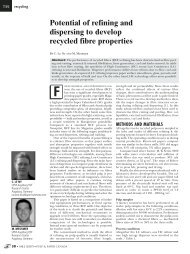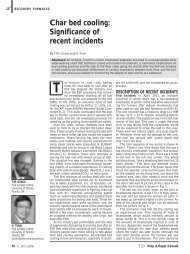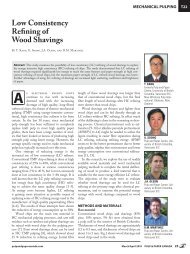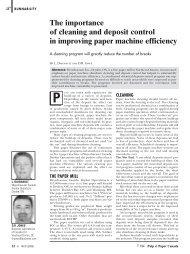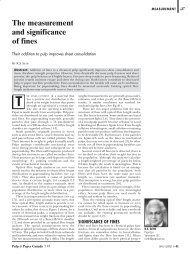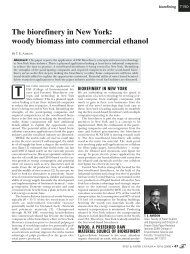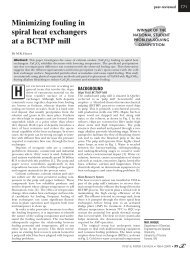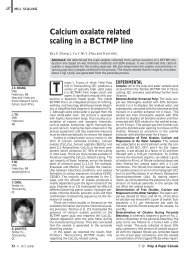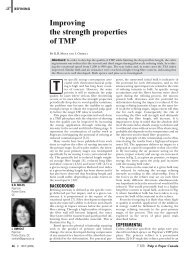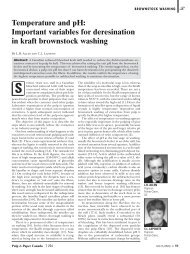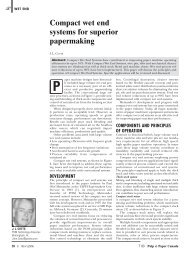Fines from deinked pulp: Effect of contaminants on their ...
Fines from deinked pulp: Effect of contaminants on their ...
Fines from deinked pulp: Effect of contaminants on their ...
You also want an ePaper? Increase the reach of your titles
YUMPU automatically turns print PDFs into web optimized ePapers that Google loves.
BRIGHTNESS<str<strong>on</strong>g>Fines</str<strong>on</strong>g> <str<strong>on</strong>g>from</str<strong>on</strong>g> <str<strong>on</strong>g>deinked</str<strong>on</strong>g> <str<strong>on</strong>g>pulp</str<strong>on</strong>g>: <str<strong>on</strong>g>Effect</str<strong>on</strong>g> <str<strong>on</strong>g>of</str<strong>on</strong>g><str<strong>on</strong>g>c<strong>on</strong>taminants</str<strong>on</strong>g> <strong>on</strong> <strong>their</strong> bleachabilityand <strong>on</strong> the <str<strong>on</strong>g>pulp</str<strong>on</strong>g> final brightnessThe importance <str<strong>on</strong>g>of</str<strong>on</strong>g> metals management is emphasizedBy L. Lapierre, D. Pitre and J. BouchardAbstract: We recently reported that the over-all brightness and bleachability <str<strong>on</strong>g>of</str<strong>on</strong>g> <str<strong>on</strong>g>deinked</str<strong>on</strong>g> <str<strong>on</strong>g>pulp</str<strong>on</strong>g>(DIP) fines were substantially lower than for the l<strong>on</strong>g fibre fracti<strong>on</strong>. It was unknown, however, whatcaused the poor bleaching resp<strong>on</strong>se <str<strong>on</strong>g>of</str<strong>on</strong>g> DIP fines. This work led us to c<strong>on</strong>clude that two factors coming<str<strong>on</strong>g>from</str<strong>on</strong>g> external c<strong>on</strong>taminati<strong>on</strong> were the main cause for the poor bleaching resp<strong>on</strong>se <str<strong>on</strong>g>of</str<strong>on</strong>g> DIP finesand low brightness ceiling: high effective residual ink and high level <str<strong>on</strong>g>of</str<strong>on</strong>g> transiti<strong>on</strong> metals, specificallyir<strong>on</strong>.L. LAPIERREPapricanPointe-Claire, QCllapierre@paprican.caD. PITREPapricanPointe-Claire,QCJ. BOUCHARDPapricanPointe-Claire,QCIN MOST Canadian mills, <str<strong>on</strong>g>deinked</str<strong>on</strong>g> <str<strong>on</strong>g>pulp</str<strong>on</strong>g>(DIP) produced <str<strong>on</strong>g>from</str<strong>on</strong>g> 70 to 85% oldnewspapers (ONP) and 15 to 30% oldmagazines (OMG) substitutes 10 to40% <str<strong>on</strong>g>of</str<strong>on</strong>g> the virgin thermomechanical<str<strong>on</strong>g>pulp</str<strong>on</strong>g> (TMP) furnish for newsprint producti<strong>on</strong>.There is a trend to use more DIP and at the sametime a demand for higher quality newspaper toallow improved coloured printing.Fibre fracti<strong>on</strong>ati<strong>on</strong> [1], which separates thel<strong>on</strong>g fibres <str<strong>on</strong>g>from</str<strong>on</strong>g> the short fibres and fines, is <strong>on</strong>emethod <str<strong>on</strong>g>of</str<strong>on</strong>g> improving the quality <str<strong>on</strong>g>of</str<strong>on</strong>g> DIP furnishes.The two fracti<strong>on</strong>s may have different end-uses,or be recombined after individually optimizedtreatments.In a previous paper [2], we reported that thel<strong>on</strong>g fibre fracti<strong>on</strong> resp<strong>on</strong>ded better to hydrogenperoxide (H 2 O 2 ) than to sodium hydrosulphite(Na 2 S 2 O 4 ), while the fines resp<strong>on</strong>ded better tosodium hydrosulphite than to hydrogen peroxide,as shown also previously by Eul et al. [3].The factors limiting the brightness gain <str<strong>on</strong>g>of</str<strong>on</strong>g> DIPfines were undetermined, i.e., it was unknownwhether it was due to a property <str<strong>on</strong>g>of</str<strong>on</strong>g> the fines ordue to residual ink. To determine the cause, weevaluated the bleachability <str<strong>on</strong>g>of</str<strong>on</strong>g> short fibre fracti<strong>on</strong>soriginating <str<strong>on</strong>g>from</str<strong>on</strong>g> three different sources: 1) <str<strong>on</strong>g>deinked</str<strong>on</strong>g><str<strong>on</strong>g>pulp</str<strong>on</strong>g>, 2) thermomechanical <str<strong>on</strong>g>pulp</str<strong>on</strong>g> (TMP)and 3) a 70:30 mixture <str<strong>on</strong>g>of</str<strong>on</strong>g> unprinted newspaperand magazines.MATERIALPulp Furnish: The three different <str<strong>on</strong>g>pulp</str<strong>on</strong>g> furnisheswere obtained <str<strong>on</strong>g>from</str<strong>on</strong>g> mills located in easternCanada.— Thermomechanical <str<strong>on</strong>g>pulp</str<strong>on</strong>g> (TMP): The never driedTMP was a mixture <str<strong>on</strong>g>of</str<strong>on</strong>g> mixed hardwood <str<strong>on</strong>g>pulp</str<strong>on</strong>g>.— Deinked <str<strong>on</strong>g>pulp</str<strong>on</strong>g> (DIP): The DIP (70:30ONP:OMG) was collected after flotati<strong>on</strong> but beforebleaching.— Unprinted newspapers and magazines: Unprintednewspapers (UNP) and unprinted magazines(UMG) were mixed in a 70:30 ratio, the sameratio as that <str<strong>on</strong>g>of</str<strong>on</strong>g> DIP. The UNP c<strong>on</strong>tained approximately30% DIP (70:30 ONP:OMG).METHODAll chemical charges are expressed as percentage<str<strong>on</strong>g>of</str<strong>on</strong>g> <str<strong>on</strong>g>pulp</str<strong>on</strong>g>, oven dry (o.d.) basis; PAPTAC standardmethods were used.Fracti<strong>on</strong>ati<strong>on</strong>: The small-scale fracti<strong>on</strong>ati<strong>on</strong> processwas carried out in a float wash-type fracti<strong>on</strong>ator[2], where a screen separated fibres primarily<strong>on</strong> the basis <str<strong>on</strong>g>of</str<strong>on</strong>g> length; separati<strong>on</strong> by flexibilitywas a sec<strong>on</strong>dary effect [4].Metal Management: Acid (A) and chelati<strong>on</strong> (Q)stages were performed at 2% c<strong>on</strong>sistency for <strong>on</strong>ehour at 50°C and followed by thorough washeswith dei<strong>on</strong>ized water. The pH <str<strong>on</strong>g>of</str<strong>on</strong>g> the A-stage wasadjusted with H 2 SO 4 to 1.50 ± 0.05 or 2.50 ± 0.05.The pH <str<strong>on</strong>g>of</str<strong>on</strong>g> the Q-stage was adjusted with H 2 SO 4to 5.3 ± 0.3, and a 0.60% charge <str<strong>on</strong>g>of</str<strong>on</strong>g> EDTA wasapplied, unless otherwise indicated.Bleaching Procedures:— Washing: After each <str<strong>on</strong>g>of</str<strong>on</strong>g> the various bleachingtreatments, the <str<strong>on</strong>g>pulp</str<strong>on</strong>g> was washed by diluting (to1% c<strong>on</strong>sistency), then thickened. The fines sampleswere thickened by centrifuging.— Peroxide bleaching: The peroxide bleachingstages were performed at 8% c<strong>on</strong>sistency using,except where indicated, a bleach liquor c<strong>on</strong>sisting<str<strong>on</strong>g>of</str<strong>on</strong>g>: 3.0% H 2 O 2 , 2.5% NaOH, 0.20% DTPA,3.0% Na 2 SiO 3 and 0.20% MgSO 4 if following anA-stage, or 0.050% MgSO 4 if following a Q-stage.Details are given in [2].— Hydrosulphite bleaching: The sodium hydrosulphitestages (Y) had a charge <str<strong>on</strong>g>of</str<strong>on</strong>g> 0.5% Na 2 S 2 O 4 <strong>on</strong><str<strong>on</strong>g>pulp</str<strong>on</strong>g> at a pH <str<strong>on</strong>g>of</str<strong>on</strong>g> 5.5 (adjusted with sulphuric acid),and performed for 30 minutes at 60°C. Detailsare given in [2].RESULTS, DISCUSSIONA look at the characterizati<strong>on</strong> <str<strong>on</strong>g>of</str<strong>on</strong>g> DIP, TMP,UNP:UMG, and <strong>their</strong> fracti<strong>on</strong>s, are discussedbelow.Fibre Length Distributi<strong>on</strong>: Bauer-McNett: Figure1 shows the Bauer-McNett histogram <str<strong>on</strong>g>of</str<strong>on</strong>g> theunfracti<strong>on</strong>ated DIP, TMP and UNP:UMG. <str<strong>on</strong>g>Fines</str<strong>on</strong>g>represented the largest fracti<strong>on</strong> in all the <str<strong>on</strong>g>pulp</str<strong>on</strong>g>s(Fig. 1). The UNP:UMG had the highest per-36 ❘❘❘ 104:8 (2003) T 208 Pulp & Paper Canada
BRIGHTNESSFIG. 1. Bauer-McNett classificati<strong>on</strong> <str<strong>on</strong>g>of</str<strong>on</strong>g> unfracti<strong>on</strong>ated <str<strong>on</strong>g>deinked</str<strong>on</strong>g><str<strong>on</strong>g>pulp</str<strong>on</strong>g> (DIP), thermomechanical <str<strong>on</strong>g>pulp</str<strong>on</strong>g> (TMP), and a mixture <str<strong>on</strong>g>of</str<strong>on</strong>g>unprinted newspaper and magazine (UNP:UMG).TABLE I. Metal i<strong>on</strong> pr<str<strong>on</strong>g>of</str<strong>on</strong>g>ile (ppm).DIP TMP UNP:UMGInitial <str<strong>on</strong>g>pulp</str<strong>on</strong>g>Ca 1500 1400 1100Fe 240 30 105Mg 300 120 175Mn 11 45 20L<strong>on</strong>g fracti<strong>on</strong>Ca 1350 1100 910Fe 45 15 33Mg 210 105 130Mn 3 0.6 1Short fracti<strong>on</strong>Ca 2000 2100 1600Fe 560 170 550Mg 440 170 240Mn 7 11 10FIG. 2. Bauer-McNett classificati<strong>on</strong> <str<strong>on</strong>g>of</str<strong>on</strong>g> the l<strong>on</strong>g fracti<strong>on</strong> <str<strong>on</strong>g>of</str<strong>on</strong>g><str<strong>on</strong>g>deinked</str<strong>on</strong>g> <str<strong>on</strong>g>pulp</str<strong>on</strong>g> (DIP), thermomechanical <str<strong>on</strong>g>pulp</str<strong>on</strong>g> (TMP), and amixture <str<strong>on</strong>g>of</str<strong>on</strong>g> unprinted newspaper and magazines(UNP:UMG).TABLE II. ISO brightness (%) <str<strong>on</strong>g>of</str<strong>on</strong>g> the original <str<strong>on</strong>g>pulp</str<strong>on</strong>g>s and <strong>their</strong>fracti<strong>on</strong>s before and after bleaching (QPY or APY; brightnessgains are in parentheses).Bleaching DIP TMP UNP:UMGUnfracti<strong>on</strong>ated <str<strong>on</strong>g>pulp</str<strong>on</strong>g>sUntreated 55.1 56.5 60.8QP or 66.9 74.1 72.1APY (+11.8) (+17.6) (+11.3)L<strong>on</strong>g fracti<strong>on</strong>sUntreated 53.8 53.4 57.5QPY or 74.7 76.4 75.0APY (+20.9) (+23.0) (+17.5)<str<strong>on</strong>g>Fines</str<strong>on</strong>g>Untreated 47.7 52.6 56.9QPY or 55.7 70.4 68.8APY (+8.0) (+17.8) (+11.9)centage <str<strong>on</strong>g>of</str<strong>on</strong>g> fines because <str<strong>on</strong>g>of</str<strong>on</strong>g> c<strong>on</strong>tributi<strong>on</strong>s<str<strong>on</strong>g>from</str<strong>on</strong>g> fillers and coating materials. TheDIP sample had the lowest P200 valuebecause soluble material had beenremoved during the flotati<strong>on</strong> applied tothis sample in the mill.The Bauer-McNett pr<str<strong>on</strong>g>of</str<strong>on</strong>g>iles <str<strong>on</strong>g>of</str<strong>on</strong>g> the l<strong>on</strong>gfracti<strong>on</strong>s <str<strong>on</strong>g>of</str<strong>on</strong>g> the three <str<strong>on</strong>g>pulp</str<strong>on</strong>g>s obtained afterfloat wash fracti<strong>on</strong>ati<strong>on</strong> were very similar(Fig. 2). The largest c<strong>on</strong>tributi<strong>on</strong>s camealmost equally <str<strong>on</strong>g>from</str<strong>on</strong>g> the R-14, 14/28 and28/48 fracti<strong>on</strong>s. The float wash fracti<strong>on</strong>atorsegregated between 85 and 89% <str<strong>on</strong>g>of</str<strong>on</strong>g> thefines material present in each sample.Metal I<strong>on</strong> Pr<str<strong>on</strong>g>of</str<strong>on</strong>g>ile: The metal i<strong>on</strong> pr<str<strong>on</strong>g>of</str<strong>on</strong>g>iles<str<strong>on</strong>g>of</str<strong>on</strong>g> the initial unfracti<strong>on</strong>ated <str<strong>on</strong>g>pulp</str<strong>on</strong>g> samples,and <str<strong>on</strong>g>of</str<strong>on</strong>g> the l<strong>on</strong>g and short fibre fracti<strong>on</strong>sare shown in Table I. Most <str<strong>on</strong>g>of</str<strong>on</strong>g> the metalc<strong>on</strong>centrati<strong>on</strong>s in the initial <str<strong>on</strong>g>pulp</str<strong>on</strong>g>s werehigher than those in the l<strong>on</strong>g fracti<strong>on</strong>s,and lower than those in the short fracti<strong>on</strong>s,indicating that the metals were c<strong>on</strong>centratedin the fines. The excepti<strong>on</strong> wasmanganese, which appears to be washedout during fracti<strong>on</strong>ati<strong>on</strong>, causing the original<str<strong>on</strong>g>pulp</str<strong>on</strong>g>s to have higher manganese levelsthan those found in either fracti<strong>on</strong>.Calcium and magnesium were presentin the fracti<strong>on</strong>s in c<strong>on</strong>centrati<strong>on</strong>s thatobeyed a mass balance. Ir<strong>on</strong> was a specialcase; it obeyed a mass balance for DIP, butthe TMP and UNP:UMG fines c<strong>on</strong>tainedmore ir<strong>on</strong> than a mass balance predicted.The expected c<strong>on</strong>centrati<strong>on</strong>s <str<strong>on</strong>g>of</str<strong>on</strong>g> ir<strong>on</strong> inthe original TMP and UNP:UMG, asdetermined by adding the c<strong>on</strong>tributi<strong>on</strong>s<str<strong>on</strong>g>from</str<strong>on</strong>g> the l<strong>on</strong>g and short fracti<strong>on</strong>s, weretwice as much as the actual measured c<strong>on</strong>centrati<strong>on</strong>s.We believe that the finesadsorbed ir<strong>on</strong> that was present in thewater used for diluti<strong>on</strong> in either a flotati<strong>on</strong>cell or a float wash fracti<strong>on</strong>ator. Thiswould explain why TMP and UNP:UMGfines collected by the float wash fracti<strong>on</strong>atorwere enriched in ir<strong>on</strong> and why the DIPfines, having been floated at the mill andenriched in ir<strong>on</strong> prior to fracti<strong>on</strong>ati<strong>on</strong>,did not lose or gain any more ir<strong>on</strong>.Bleachability <str<strong>on</strong>g>of</str<strong>on</strong>g> Pulps and Pulp Fracti<strong>on</strong>s:Table II lists the ISO brightness <str<strong>on</strong>g>of</str<strong>on</strong>g> the<str<strong>on</strong>g>pulp</str<strong>on</strong>g>s and those <str<strong>on</strong>g>of</str<strong>on</strong>g> the l<strong>on</strong>g and short fracti<strong>on</strong>sbefore and after QPY or APY; thesetwo sequences led to the same results. Thebrightness gains are in parentheses.Unbleached unfracti<strong>on</strong>ated <str<strong>on</strong>g>pulp</str<strong>on</strong>g>s werealways brighter than <strong>their</strong> fracti<strong>on</strong>atedcomp<strong>on</strong>ents and unbleached fines hadthe lowest brightness due to <strong>their</strong> highlignin c<strong>on</strong>tent and, in the case <str<strong>on</strong>g>of</str<strong>on</strong>g> DIP,high ERIC values (450 ppm). The higherbrightness <str<strong>on</strong>g>of</str<strong>on</strong>g> the unfracti<strong>on</strong>ated <str<strong>on</strong>g>pulp</str<strong>on</strong>g>sindicated that the positive effect <str<strong>on</strong>g>of</str<strong>on</strong>g> fines<strong>on</strong> light scattering is greater than <strong>their</strong>negative effect <strong>on</strong> light absorpti<strong>on</strong>.After bleaching, the l<strong>on</strong>g fracti<strong>on</strong><str<strong>on</strong>g>pulp</str<strong>on</strong>g>s were the brightest. The brightnessgains show that these <str<strong>on</strong>g>pulp</str<strong>on</strong>g>s resp<strong>on</strong>dedbest to the bleaching chemicals.The final brightnesses <str<strong>on</strong>g>of</str<strong>on</strong>g> the l<strong>on</strong>gfracti<strong>on</strong> <str<strong>on</strong>g>pulp</str<strong>on</strong>g>s were relatively independent<str<strong>on</strong>g>of</str<strong>on</strong>g> the fibre source (ISO brightnessesafter QPY: DIP, 74.7%; TMP, 76.4%;and UNP:UMG, 75.0%, for an over-allaverage <str<strong>on</strong>g>of</str<strong>on</strong>g> 75.4 ± 0.9%). However, thefinal brightnesses <str<strong>on</strong>g>of</str<strong>on</strong>g> the bleached unfrac-Pulp & Paper Canada T 209 104:8 (2003) ❘❘❘ 37
BRIGHTNESSTABLE III. ISO brightness (%) <str<strong>on</strong>g>of</str<strong>on</strong>g> the short fracti<strong>on</strong>s (fines)obtained after different bleaching sequences (brightnesschanges are in parentheses).BleachingSequence DIP TMP UNP:UMGFIG. 3. ISO brightness <str<strong>on</strong>g>of</str<strong>on</strong>g> DIP and TMP furnishes, c<strong>on</strong>sisting<str<strong>on</strong>g>of</str<strong>on</strong>g> the bleached (QPY) l<strong>on</strong>g fracti<strong>on</strong> mixed with <strong>their</strong>respective bleached (QPY) fines counterparts, in ratiosranging <str<strong>on</strong>g>from</str<strong>on</strong>g> 70:30 to 100:0 l<strong>on</strong>g fracti<strong>on</strong>: fines.Untreated 47.7 52.6 56.9Y 49.4 56.5 —(+1.7) (+3.9)QY or 54.4 59.5 —AY (+6.7) (+6.9)P 45.4 62.6 57.5(–2.3) (+10.0) (+0.6)QP or *50.0* 66.5 67.2AP (+2.3) (+13.9) (+10.3)QPY or *55.7* 70.4 68.8APY (+8.0) (+17.8) (+11.9)*: A 1.2% EDTA charge was applied in the Q-stage and 0.2% MgSO 4added in the P-stage, a departure <str<strong>on</strong>g>from</str<strong>on</strong>g> the procedure described in theexperimental secti<strong>on</strong>.ti<strong>on</strong>ated <str<strong>on</strong>g>pulp</str<strong>on</strong>g>s differed: DIP had thelowest ISO brightness at 66.9%, followedby UNP:UMG at 72.1% and TMP at74.1%. The same order was seen forthe ISO brightnesses <str<strong>on</strong>g>of</str<strong>on</strong>g> the bleachedfines: DIP, 55.7%; UNP:UMG, 68.8%; andTMP 70.4%.The above results indicate that the lowfinal brightness <str<strong>on</strong>g>of</str<strong>on</strong>g> the DIP after QPY wasa direct c<strong>on</strong>sequence <str<strong>on</strong>g>of</str<strong>on</strong>g> the poor bleachabilityand low brightness <str<strong>on</strong>g>of</str<strong>on</strong>g> the DIP fines.To c<strong>on</strong>firm this, we measured the ISObrightness <str<strong>on</strong>g>of</str<strong>on</strong>g> DIP and TMP furnishes,c<strong>on</strong>sisting <str<strong>on</strong>g>of</str<strong>on</strong>g> the bleached (QPY) l<strong>on</strong>gfracti<strong>on</strong>s mixed with <strong>their</strong> respectivebleached (QPY) fines, in ratios ranging<str<strong>on</strong>g>from</str<strong>on</strong>g> 70:30 to 100:0 l<strong>on</strong>g fracti<strong>on</strong>:fines.The results, Fig. 3, show that the 100:0DIP furnish had an ISO brightness <str<strong>on</strong>g>of</str<strong>on</strong>g>75.1%, while the 70:30 DIP furnish had abrightness <str<strong>on</strong>g>of</str<strong>on</strong>g> 66.4%, a drop <str<strong>on</strong>g>of</str<strong>on</strong>g> 8.7 brightnesspoints. Under the same c<strong>on</strong>diti<strong>on</strong>swith TMP, the ISO brightness went <str<strong>on</strong>g>from</str<strong>on</strong>g>76.7% to 74.7%, a drop <str<strong>on</strong>g>of</str<strong>on</strong>g> <strong>on</strong>ly 2.0 brightnesspoints.<str<strong>on</strong>g>Fines</str<strong>on</strong>g> Bleachability: The bleachability <str<strong>on</strong>g>of</str<strong>on</strong>g>the fines <str<strong>on</strong>g>of</str<strong>on</strong>g> the three furnishes, obtained<str<strong>on</strong>g>from</str<strong>on</strong>g> the float wash fracti<strong>on</strong>ator, wasevaluated for the following bleachingsequences: Y, QY, AY, P, QP, AP, QPYand APY. Again, A and Q treatmentswere equivalent and thus tabulated together.Table III summarizes thesebleaching results.— <str<strong>on</strong>g>Fines</str<strong>on</strong>g> bleaching: DIP vs. TMP: DIP finesdid not resp<strong>on</strong>d as well as TMP fines toperoxide or hydrosulphite bleaching. Thehigh 450-ppm ERIC value <str<strong>on</strong>g>of</str<strong>on</strong>g> the DIPfines, compared to <strong>on</strong>ly 75 ppm for theTMP fines, explains the low brightnessceiling and partially explains the poorapparent bleachability <str<strong>on</strong>g>of</str<strong>on</strong>g> the DIP fines.The higher level <str<strong>on</strong>g>of</str<strong>on</strong>g> ir<strong>on</strong> in the DIP finesaccounts for the remaining difference inbleaching resp<strong>on</strong>se.Using the following equati<strong>on</strong>s,Brightness= 1 + k/s – (2 k/s + (k/s) 2 ) 1/2k (fines+ink) = k fines + c ink k inks (fines+ink) = s fineswhere k is the absorpti<strong>on</strong> coefficient, s thescattering coefficient, c ink the ink c<strong>on</strong>centrati<strong>on</strong>and k ink = 15000 m 2 /kg [5], <strong>on</strong>e cancalculate the effect <str<strong>on</strong>g>of</str<strong>on</strong>g> ink <strong>on</strong> brightness.The DIP fines had an ISO brightness <str<strong>on</strong>g>of</str<strong>on</strong>g>47.7%, a scattering coefficient, s (fines+ink) ,<str<strong>on</strong>g>of</str<strong>on</strong>g> 100 m 2 /kg and an ERIC value <str<strong>on</strong>g>of</str<strong>on</strong>g> 450ppm. We calculated that k (fines+ink) = 28.7m 2 /kg, k fines = 21.9 m 2 /kg and (c ink k ink ) =6.8 m 2 /kg. If ink was absent, thenk (fines+ink) = k fines = 21.9 m 2 /kg, and theinkless brightness would be 52.2%.During the QPY sequence, k ink <str<strong>on</strong>g>of</str<strong>on</strong>g> blackink remains unchanged and therefore, forthe ink-c<strong>on</strong>taining DIP fines to gain 8.0brightness points over-all and reach55.7%, the brightness <str<strong>on</strong>g>of</str<strong>on</strong>g> the DIP finesal<strong>on</strong>e would have to be 63.0% i.e.,(k (fines+ink) would need to be 17.6 m 2 /kgand k fines 10.9 m 2 /kg). For the ink-c<strong>on</strong>tainingDIP fines to have a brightness <str<strong>on</strong>g>of</str<strong>on</strong>g>68%, the fines al<strong>on</strong>e would have to reacha brightness <str<strong>on</strong>g>of</str<strong>on</strong>g> 90%! The high ERIC value<str<strong>on</strong>g>of</str<strong>on</strong>g> the DIP fines thus limits <strong>their</strong> brightnessceiling and brightness gain. The finalISO brightness <str<strong>on</strong>g>of</str<strong>on</strong>g> the DIP fines afterbleaching can, therefore, <strong>on</strong>ly be furtherimproved by removing additi<strong>on</strong>al ink, notby additi<strong>on</strong>al bleaching <str<strong>on</strong>g>of</str<strong>on</strong>g> fibres.Other than the difference in ERIC value,the DIP fines c<strong>on</strong>tained significantlymore ir<strong>on</strong> than the TMP fines. The excepti<strong>on</strong>allyhigh c<strong>on</strong>centrati<strong>on</strong>s <str<strong>on</strong>g>of</str<strong>on</strong>g> ir<strong>on</strong> in thefines, especially the DIP fines, significantlyreduced the bleaching efficiency <str<strong>on</strong>g>of</str<strong>on</strong>g>hydrosulphite. Hydrosulphite bleachingwas less efficient for DIP fines than forTMP fines (ISO brightness gain <str<strong>on</strong>g>of</str<strong>on</strong>g> 1.7%vs. 3.9%, respectively). As a result, whenthe Y-stage was preceded by a metal-managementstage, hydrosulphite bleachingefficiency was restored giving ISO brightnessgains <str<strong>on</strong>g>of</str<strong>on</strong>g> 6.9 and 6.7 points for DIPand TMP fines, respectively.The high level <str<strong>on</strong>g>of</str<strong>on</strong>g> metals in the DIPfines fracti<strong>on</strong> prevented any benefit <str<strong>on</strong>g>from</str<strong>on</strong>g>peroxide bleaching. Without a metal-managementstage, a P-stage caused a brightnessloss: the peroxide residual was niland the high pH caused alkali darkening<str<strong>on</strong>g>of</str<strong>on</strong>g> the <str<strong>on</strong>g>pulp</str<strong>on</strong>g>. The best P-stage resultsoccurred following either an acid wash atpH 1.5 or a Q-stage using a 1.2% charge<str<strong>on</strong>g>of</str<strong>on</strong>g> EDTA, twice the amount required forthe unfracti<strong>on</strong>ated <str<strong>on</strong>g>pulp</str<strong>on</strong>g> and the l<strong>on</strong>g fracti<strong>on</strong>s.At this dosage, the magnesium inthe <str<strong>on</strong>g>pulp</str<strong>on</strong>g> was also depleted and needed tobe replenished for optimal peroxidebleaching efficiency. The metal-managementstages decreased the ir<strong>on</strong> c<strong>on</strong>centrati<strong>on</strong>by about 100 ppm (<str<strong>on</strong>g>from</str<strong>on</strong>g> 560 to460 ppm), with the subsequent peroxidestage giving an ISO brightness 4.6 pointshigher than the case with no pre-treatment,for a net ISO brightness gain <str<strong>on</strong>g>of</str<strong>on</strong>g><strong>on</strong>ly 2.3 points.The TMP fines, which had an Fe c<strong>on</strong>tent3.5 times less than that <str<strong>on</strong>g>of</str<strong>on</strong>g> the DIPfines (i.e., 170 ppm vs. 560 ppm), resp<strong>on</strong>dedmuch better to peroxide bleachingthan DIP fines. Even without a metalmanagementstage, the ISO brightnessgain was 10 points. A metal-managementstage provided an additi<strong>on</strong>al ISO brightnessgain <str<strong>on</strong>g>of</str<strong>on</strong>g> ~4 points, similar to the benefitobserved with the DIP fines.A metal-management stage clearlyimproved the P-stage to a greater extentthan the Y-stage, dem<strong>on</strong>strating thegreater sensitivity <str<strong>on</strong>g>of</str<strong>on</strong>g> hydrogen peroxidetowards transiti<strong>on</strong> metals.A QPY/APY stage brought the finalISO brightness <str<strong>on</strong>g>of</str<strong>on</strong>g> the TMP fines to 70.4%(a gain <str<strong>on</strong>g>of</str<strong>on</strong>g> ~18 brightness points), and <str<strong>on</strong>g>of</str<strong>on</strong>g>the DIP fines to 55.7% (a gain <str<strong>on</strong>g>of</str<strong>on</strong>g> 8 brightnesspoints). The effectiveness <str<strong>on</strong>g>of</str<strong>on</strong>g> the Y-stage decreased when preceded by an efficientP-stage; the two stages do not38 ❘❘❘ 104:8 (2003) T 210 Pulp & Paper Canada
BRIGHTNESSperfectly complement each other [6].— <str<strong>on</strong>g>Fines</str<strong>on</strong>g> <str<strong>on</strong>g>from</str<strong>on</strong>g> UNP:UMG: The fines <str<strong>on</strong>g>from</str<strong>on</strong>g> UNP:UMG (Table III)had the highest brightness due to <strong>their</strong> origin (30% bleachedmagazine at an ISO brightness <str<strong>on</strong>g>of</str<strong>on</strong>g> 68%, and 70% <str<strong>on</strong>g>of</str<strong>on</strong>g> newsprint atan ISO brightness <str<strong>on</strong>g>of</str<strong>on</strong>g> 60.4%). The ERIC value <str<strong>on</strong>g>of</str<strong>on</strong>g> the UNP:UMGfines was 125 ppm, higher than the 75 ppm for the TMP fines,but lower than the 450-ppm <str<strong>on</strong>g>of</str<strong>on</strong>g> the DIP fines. The 30% DIP c<strong>on</strong>tentin the UNP could explain this intermediate ERIC value.Due to <strong>their</strong> prior bleaching history, high Fe c<strong>on</strong>centrati<strong>on</strong> andink carried over <str<strong>on</strong>g>from</str<strong>on</strong>g> recycling, the UNP:UMG fines bleachabilitywas intermediate to those <str<strong>on</strong>g>of</str<strong>on</strong>g> the DIP and TMP; however,<strong>their</strong> final brightness was <strong>on</strong>ly slightly lower than that <str<strong>on</strong>g>of</str<strong>on</strong>g> theTMP fines.The peroxide bleaching resp<strong>on</strong>se was poor when it was notpreceded by a metal-management stage (<strong>on</strong>ly 0.6 <str<strong>on</strong>g>of</str<strong>on</strong>g> a brightnesspoint); however, it was still better than the DIP fines resp<strong>on</strong>se(–2.3 brightness points), but less than the TMP fines resp<strong>on</strong>se(10.0 brightness points). A metal-management stage improvedthe ISO brightness gain following peroxide bleaching by nearly10 points, to 67.2%. The ISO brightness increase was betweenthat <str<strong>on</strong>g>of</str<strong>on</strong>g> DIP (2.3 brightness points) and TMP (13.9 brightnesspoints), but the final brightness was similar to that <str<strong>on</strong>g>of</str<strong>on</strong>g> the TMP.The maximum ISO brightness gain was 11.9 points following aQPY-stage, less than the 17.8 brightness points gain for TMP butgreater than the 8.0 brightness points for DIP. The maximumISO brightness attained for the UNP:UMG fines was 68.8%,close to the 70.4% value for the TMP fines, and definitely higherthan that <str<strong>on</strong>g>of</str<strong>on</strong>g> the DIP fines (55.7%).We can c<strong>on</strong>clude that fines that have never been throughprinting resp<strong>on</strong>d well to bleaching reagents, provided they aretreated with a metal-management stage. For each furnish, theratio <str<strong>on</strong>g>of</str<strong>on</strong>g> the maximum ISO brightness gains <str<strong>on</strong>g>of</str<strong>on</strong>g> the fines (TableIII) over that <str<strong>on</strong>g>of</str<strong>on</strong>g> the original <str<strong>on</strong>g>pulp</str<strong>on</strong>g>s (Table II) were 0.68 for DIP(8.0/11.8), 1.01 for TMP (17.8/17.6) and 1.05 for UNP:UMG(11.9/11.3), which illustrates again how the high ERIC <str<strong>on</strong>g>of</str<strong>on</strong>g>the DIP fines limited the final brightness gain <str<strong>on</strong>g>of</str<strong>on</strong>g> the unfracti<strong>on</strong>ated<str<strong>on</strong>g>pulp</str<strong>on</strong>g>s.It is interesting to note that the l<strong>on</strong>g fracti<strong>on</strong>s <str<strong>on</strong>g>of</str<strong>on</strong>g> the DIP andUNP:UMG had similar brightness gains and final brightnesses(Table II), while <strong>their</strong> fines bleachability differed significantly.Therefore, the processing <str<strong>on</strong>g>of</str<strong>on</strong>g> the <str<strong>on</strong>g>pulp</str<strong>on</strong>g> into paper did not significantlyaffect its bleachability, as noted previously by Galland etal. [7]. However, the printing process did affect the bleachabilitydue to the poor deinking <str<strong>on</strong>g>of</str<strong>on</strong>g> the fines.CONCLUSIONInk was extremely difficult to detach and seemed to be permanentlybound to the DIP fines; it was the major factor limiting<strong>their</strong> brightness gain.Ir<strong>on</strong> had a str<strong>on</strong>g affinity for fines. Without a proper metalmanagementstage, <strong>their</strong> high level <str<strong>on</strong>g>of</str<strong>on</strong>g> ir<strong>on</strong> decreased the performance<str<strong>on</strong>g>of</str<strong>on</strong>g> hydrosulphite bleaching. The peroxide bleachingefficiency <strong>on</strong> fines <str<strong>on</strong>g>from</str<strong>on</strong>g> UNP:UMG or DIP was practically nilwithout an acid wash or a chelati<strong>on</strong> stage.Therefore, even if fines have a higher percentage <str<strong>on</strong>g>of</str<strong>on</strong>g> ligninthan the l<strong>on</strong>g fracti<strong>on</strong>, they can nevertheless be bleached tohigh brightness if they are not c<strong>on</strong>taminated by ink. To bleachDIP to high brightness, either fines have to be removed or a processto detach and remove ink <str<strong>on</strong>g>from</str<strong>on</strong>g> fines is necessary.The fines that had been processed, for example, througha paper machine, had a brightness ceiling similar to the finesthat had not been processed, as l<strong>on</strong>g as ink was absent <str<strong>on</strong>g>from</str<strong>on</strong>g>that process.LITERATURE1. SCOTT, G.M., ABUBAKR, S. Fracti<strong>on</strong>ati<strong>on</strong> <str<strong>on</strong>g>of</str<strong>on</strong>g> sec<strong>on</strong>dary fiber — A review. Prog.Pap. Recycling 3: 50-59 (1994).2. LAPIERRE, L., PITRE, D., BOUCHARD, J. Bleaching <str<strong>on</strong>g>of</str<strong>on</strong>g> <str<strong>on</strong>g>deinked</str<strong>on</strong>g> recycled <str<strong>on</strong>g>pulp</str<strong>on</strong>g>:benefits <str<strong>on</strong>g>of</str<strong>on</strong>g> fibre fracti<strong>on</strong>ati<strong>on</strong>. Pulp Paper Can. 102(2): 35-38 (2001).3. EUL, W., SÜSS, H.U., HELMLING, O. Fibre fracti<strong>on</strong>ati<strong>on</strong> and post-treatment <str<strong>on</strong>g>of</str<strong>on</strong>g>de-inked <str<strong>on</strong>g>pulp</str<strong>on</strong>g>. Pulp Paper Can. 90(10): T391-397 (1989).4. KARNIS, A. Pulp fracti<strong>on</strong>ati<strong>on</strong> by fibre characteristics. Pap. Puu 79(7): 480-488(1997).5. JORDAN, B., O’NEIL, M. The Kubelka-Munk absorpti<strong>on</strong> coefficient <str<strong>on</strong>g>of</str<strong>on</strong>g> severalcarb<strong>on</strong> blacks and water based printing inks. JPPS 20(12): J371-375 (1994).6. AUHORN, W., MELZER, J. Ec<strong>on</strong>omical integrati<strong>on</strong> <str<strong>on</strong>g>of</str<strong>on</strong>g> mechanical <str<strong>on</strong>g>pulp</str<strong>on</strong>g> bleachinginto modern paper technology. Wochenbl. Papierfabr. 110(8): 255-262 (1982).7. GALLAND, G., BERNARD, G., SAURET, G. Désencrage: Intérêt des traitements«haute c<strong>on</strong>centrati<strong>on</strong>», Rev. ATIP 37(9): 559-566 (1983).Résumé: Nous av<strong>on</strong>s récemment présenté un rapport indiquantque la blancheur et l’aptitude au blanchiment des fines de pâte désencrée(PDE) étaient en général substantiellement inférieures à celles dela fracti<strong>on</strong> de fibres l<strong>on</strong>gues. Nous ne savi<strong>on</strong>s pas à ce moment ce quiavait entraîné la pauvre rép<strong>on</strong>se des fines de PDE aux agents deblanchiment. Nous av<strong>on</strong>s c<strong>on</strong>clu que deux facteurs liés à la c<strong>on</strong>taminati<strong>on</strong>externe étaient la cause principale de la pauvre rép<strong>on</strong>se aublanchiment et au faible degré de blancheur maximale des fines dePDE : un taux effectif élevé d’encre résiduelle et une forte quantité demétaux de transiti<strong>on</strong>, principalement le fer.Reference: LAPIERRE, L., PITRE, D., BOUCHARD, J. <str<strong>on</strong>g>Fines</str<strong>on</strong>g> <str<strong>on</strong>g>from</str<strong>on</strong>g><str<strong>on</strong>g>deinked</str<strong>on</strong>g> <str<strong>on</strong>g>pulp</str<strong>on</strong>g>: <str<strong>on</strong>g>Effect</str<strong>on</strong>g> <str<strong>on</strong>g>of</str<strong>on</strong>g> <str<strong>on</strong>g>c<strong>on</strong>taminants</str<strong>on</strong>g> <strong>on</strong> <strong>their</strong> bleachability and <strong>on</strong> the<str<strong>on</strong>g>pulp</str<strong>on</strong>g> final brightness. Pulp & Paper Canada 104(8): T208-211 (August2003). Paper presented at the 6th Research Forum <strong>on</strong> Recycling inMagog, QC, <strong>on</strong> October 1 to 4, 2001. Not to be reproduced without permissi<strong>on</strong><str<strong>on</strong>g>of</str<strong>on</strong>g> PAPTAC. Manuscript received <strong>on</strong> August 10, 2001. Revisedmanuscript approved for publicati<strong>on</strong> by the Review Panel <strong>on</strong> December5, 2002.Keywords: FINES, DEINKED STOCK, BRIGHTNESS, BLEACH-ABILITY, CONTRARIES, TRANSITION METALS.Pulp & Paper Canada T 211 104:8 (2003) ❘❘❘ 39



